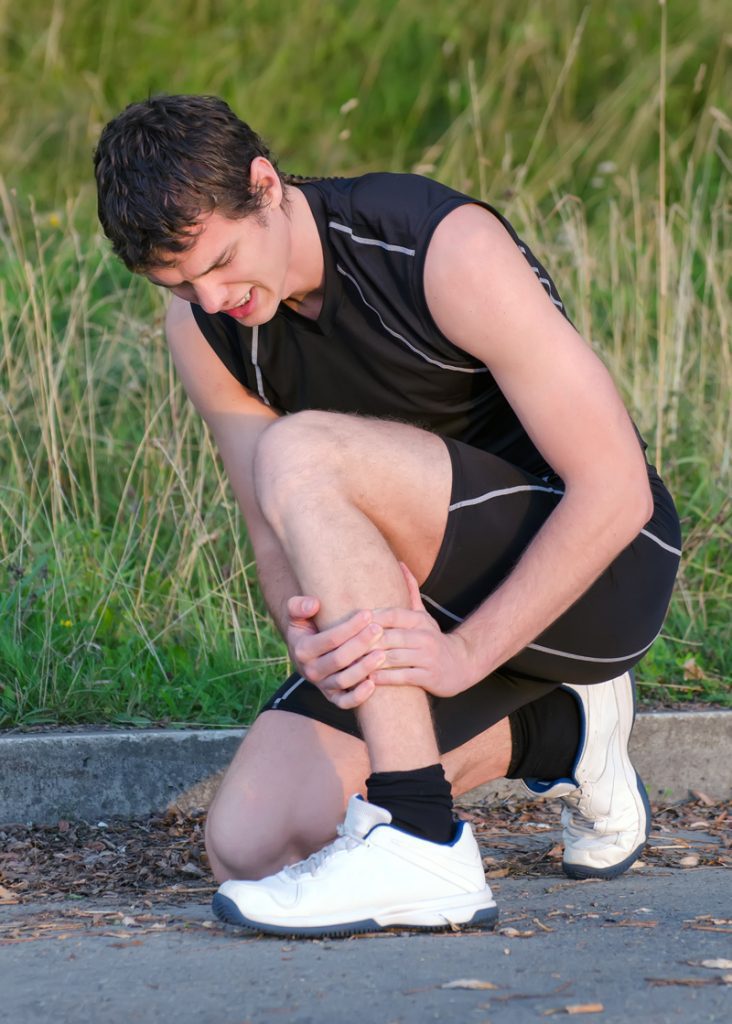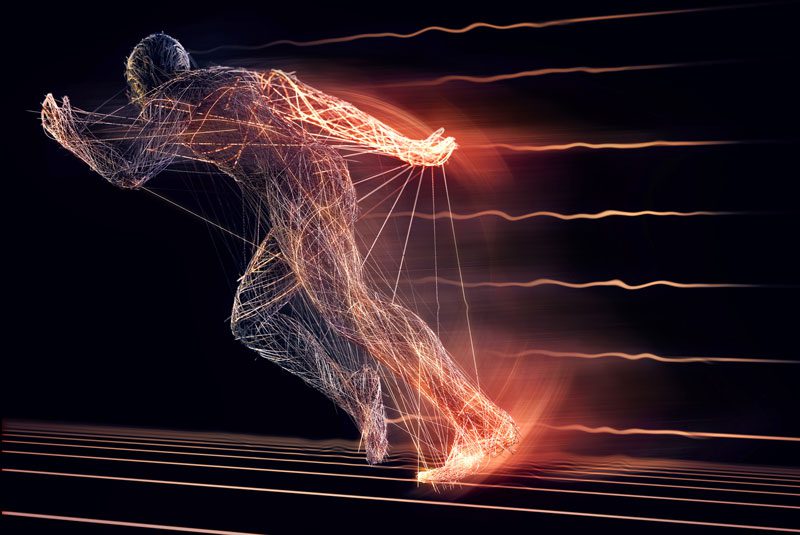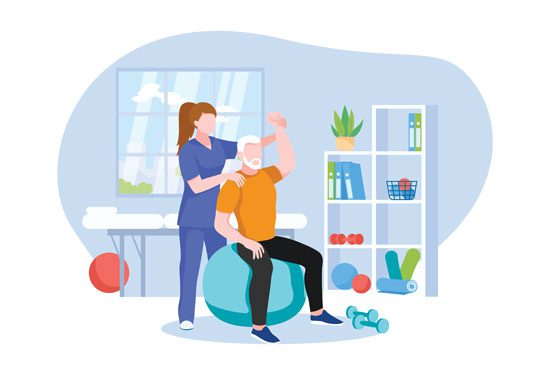
Knee & Shoulder Injuries
According to Dr. Kasik, knee and shoulder injuries are also common. Dr. Shin adds, “The most common injuries typically seen in a sports medicine office would be rotator cuff injuries, shoulder labral injuries, ankle sprains and knee injuries and including meniscal tears and ligament tears.” He goes on to explain that most often, these injuries happen after a blow or force (such as getting tackled in football). He further adds that chronic overuse injuries, such as stress fractures or tendonitis, occur due to repetitive training like running, throwing a baseball or swinging a tennis racket. However, injuries can happen simply from abnormal twisting, bending, reaching or falling as well. Sometimes, you may not even realize what you did to cause the injury.
Because your knees and shoulders endure a lot of impact, weight and use during sports and recreational activities, as well as, work-related tasks and home projects, many people injure one or more at some point in their life.
Tennis Elbow (Epicondylitis)
Athletes aren’t the only people who get “tennis elbow.” Tennis elbow, or lateral epicondylitis, is inflammation or microtearing of the tendons that join the forearm muscles on the outside of the elbow. Many people with tennis elbow participate in activities that require repetitive and vigorous use of the forearm muscle or repetitive extension of the wrist and hand. According to the American Academy of Orthopaedic Surgeons, painters, plumbers and carpenters are prone to developing tennis elbow.
Are You Injured?
Whether you are just a beginner, an intermediate or a pro athlete, there’s always a chance of injury. Many injuries that fall under the specialty of sports medicine don’t always occur during sports. Injuries can happen in whatever you are doing if one moves wrong, trips and falls or makes sudden contact with the ground or another individual. Injuries can happen just as often while doing household tasks as they can on the field or court. Our sports medicine specialists are here to help get you back to doing what you love.
While this is not a complete list of injuries our sports medicine specialists treat, here are some of the more common ones encountered by our specialists:
Strains & Sprains
“The most common injuries in sports medicine are sprains and strains (pulled muscles),” states Connor Kasik, DO, board certified orthopedic surgeon at St. Margaret’s. “Most commonly, this occurs in the ankle or hamstring,” he continues. Strains happen when you overstretch a muscle or tendon and a sprain is the stretching or tearing of ligaments, which are the tough bands of fibrous tissue that connects two bones. Sprains can be painful and take longer to heal than strains.
According to Michael Shin, MD, another one of our board certified orthopedic surgeons, if you have an injury, it is important to begin Rest-Ice-Compression-Elevation (RICE). He explains that RICE, along with over-the-counter (OTC) anti-inflammatories can work for many issues. However, Dr. Shin emphasizes “severe pains and pains that have been going on and not improving or [are] getting worse over a period of time should be seen. Some of these sports medicine-related issues are typically easier and quicker to treat the [sooner] we get to them.”


600 East First Street
Second Floor
Spring Valley, IL

600 East First Street
Third Floor
Spring Valley, IL

920 West Street
Suite 211
Peru, IL

Treatments & When to See a Sports Medicine Specialist
Treatment can depend on the location, type and severity of the injury, as well as your age, overall wellness and activity level. As mentioned earlier, common treatments to help heal these injuries should begin Rest-Ice-Compression-Elevation (RICE) and OTC anti-inflammatories. Do not wait to begin treating an injury. Even if medical help is on the way, you can begin RICE.
Rest
Often, rest and restricting activity can help prevent further injury and allow the area some time to begin healing. Movement can further damage, irritate and inflame certain injuries.
Ice
Dr. Kasik recommends applying ice immediately after an injury occurs, using ice for 20 minutes every one to two hours for the first 48 hours after injury. He adds not to use heat during this time as it encourages swelling and inflammation.
Compression
Applying compression with an elastic bandage is another way that Dr. Kasik says will help reduce swelling. Mayo Clinic notes to be sure not to wrap the bandage too tightly—hindering circulation. Keep the area compressed until the swelling stops and loosen it if the pain increases, the area becomes numb, or swelling is occurring below the wrapped area.
Elevation
While gravity is not always your friend, in this case, it can be extremely helpful in reducing swelling when you elevate the injured area above the heart. Mayo Clinic notes that this is especially important to do at night.
Prevention
As Dr. Shin wisely notes, “Like many things in life and in medicine, prevention is key.” While we cannot anticipate everything that we will face in a day to prepare our bodies and prevent injury, there are some things that we can do to maintain agility, strength and flexibility.
To avoid de-conditioning of your muscles and ligaments and help prevent injury, Dr. Kasik recommends:
- Workout daily and enjoy your weekend activities.
- Starting every workout with a gentle warm-up will increase flexibility and improve blood flow to muscles.
- Begin pre-participation training first. Doing so helps prevent overuse injuries by lightly working the relevant muscle groups in the weeks before the activity.
- Stop when you are fatigued. Muscle fatigue takes away all your protective mechanisms and increases your risk of overall injury.
If you are unsure of the best ways to safely stretch and work out specific parts of your body, Dr. Shin recommends finding quality sources on the internet. He stated that there is so much free information out there on specific stretches for specific body parts, sports and injuries, adding that YouTube is a great tool for watching videos on someone performing and giving pointers on how to perform specific stretches. For many, seeing a stretch performed may be more helpful than just reading about it. However, be cautious when searching online, and always make sure the sources of information you use are reputable.


Regarding further treatment, Dr. Shin states, “Depending on the issue and the severity of it, the treatments can range from medications, physical therapy, injections, bracing or surgery.” He also adds, “I think many patients are pleasantly surprised to see that for many issues we try non-operative options first, and only if patients fail those non-operative options would surgery be the recommendation.” However, he notes that for more serious injuries, like fractures, as well as UCL and ACL tears, surgery would be required.
Based on the type and severity of your injury, some healing can take more time than others. “Some common sports injuries may take months to heal, even with good treatment,” says Dr. Kasik.
Remember, the earlier you seek treatment, the faster the healing. If you are not seeing improvement or your symptoms are worsening, seek medical care. Waiting weeks to see your doctor may set your recovery time back further than if you sought medical care earlier.

Dr. Kasik recommends you see a doctor if you suspect a serious injury or if you have any of these signs:
- Deformities in the joint or bone — it looks crooked, moves abnormally, cannot bear weight or it gives way
- Excessive swelling
- Excessive pain
- Pain with activity
- A painful limp
- Limited range of motion
- Changes in skin color beyond mild bruising
- No improvement after a few days of rest, ice, compression and elevation















